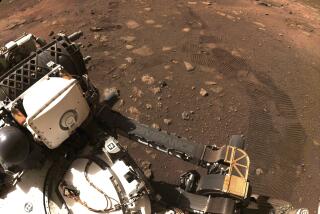Mars rover begins descent into crater
- Share via
After surviving the harshest dust storm in its nearly four-year trek on Mars, the rover Opportunity got back to work Tuesday, dipping its toe into 260-foot-deep Victoria Crater.
Opportunity rolled its six wheels about 10 feet into the crater, then backed out in a maneuver its handlers at the Jet Propulsion Laboratory in La Cañada Flintridge dubbed “the hokeypokey.”
As it backed out, Opportunity slipped on a sandy ripple at the crater’s edge and halted, said rover project manager John Callas. Engineers plan to adjust Opportunity’s settings to handle the slippage before going back into the crater to explore.
“We want to understand the conditions,” Callas said. “We want to make sure we can get back out.”
The crater exploration is risky. If the rover malfunctions, or the terrain is more difficult than expected, this could be Opportunity’s last trip. Rover managers decided to make the trip after determining the rewards outweighed the risks.
“For almost two years now, we’ve felt that Victoria Crater was the most compelling science for Opportunity,” Callas said.
Opportunity spent months surveying the crater, the largest it has encountered since the rover and its twin, Spirit, landed on the Martian surface in 2004. After reaching Victoria Crater last September, the rover trundled along the rim, taking pictures and looking for a good entry site.
After traversing a quarter of the crater perimeter, scientists decided to return Opportunity to the spot it examined first, a sloping region known as Duck Bay.
Victoria Crater formed billions of years ago when a meteorite smashed into the planet. In the crater’s walls, researchers expect to find layered strata similar to the rock layers in the Grand Canyon. Each layer represents an era of Martian history.
The rover team is particularly interested in something called “the bathtub ring,” a layer of strata part way down that Callas said may represent the ancient surface of Mars.
Farther down, scientists hope to uncover more “blueberries,” marble-like outcrops that formed from ancient water flows when the surface of Mars was a wetter place than today’s desiccated landscape.
Callas said the science team did not intend to send Opportunity to the bottom of the crater. It’s filled with a layer of fine sand that could trap the rover, he said.
Besides the long search for a good entry point, Opportunity’s descent was delayed by the most intense dust storm either rover has encountered.
Opportunity and Spirit are solar-powered, so they must shut down during inclement weather.
Originally intended to last three months, the rover missions are now approaching their fourth anniversary. Opportunity has trekked seven miles across the dusty surface of the Red Planet.
Spirit, though hobbled and dragging one inoperative wheel, also is back on the job on the other side of the planet, investigating a geologic feature called Home Plate.
Callas expects Opportunity to spend a few months in Victoria Crater. But he’s already got his eye on future targets, such as a set of loose rocks, called cobbles, that may be meteorites or material that flew out of the crater when the meteorite hit.
--






